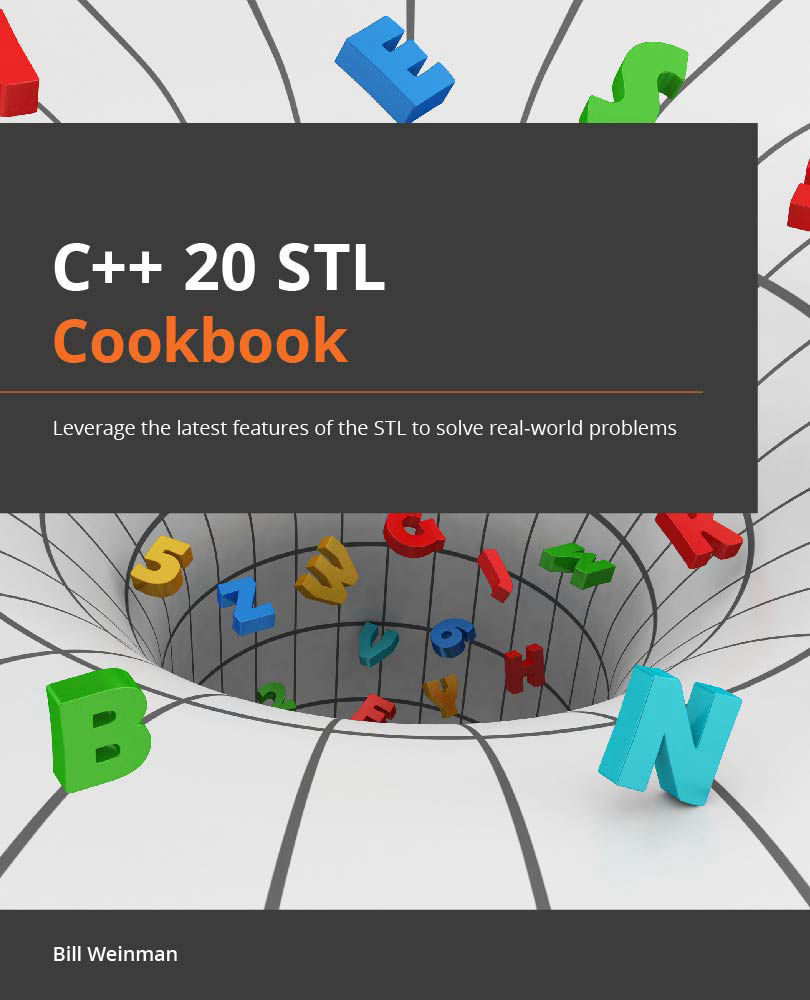-
Book Overview & Buying

-
Table Of Contents

C++20 STL Cookbook
By :

C++20 STL Cookbook
By:
Overview of this book
 Free Chapter
Free Chapter
 Sign In
Start Free Trial
Sign In
Start Free Trial

 Free Chapter
Free Chapter
Structured binding makes it easy to unpack the values of a structure into separate variables, improving the readability of your code.
With structured binding you can directly assign the member values to variables like this:
things_pair<int,int> { 47, 9 };
auto [this, that] = things_pair;
cout << format("{} {}\n", this, that);
Output:
47 9
pair, tuple, array, and struct. Beginning with C++20, this includes bit-fields. This example uses a C-array: int nums[] { 1, 2, 3, 4, 5 };
auto [ a, b, c, d, e ] = nums;
cout << format("{} {} {} {} {}\n", a, b, c, d, e);Output:
1 2 3 4 5
Because the structured binding uses automatic type deduction, its type must be auto. The names of the individual variables are within the square brackets, [ a, b, c, d, e ].
In this example the int C-array nums holds five values. These five values are assigned to the variables (a, b, c, d, and e) using structured binding.
array object:array<int,5> nums { 1, 2, 3, 4, 5 };
auto [ a, b, c, d, e ] = nums;
cout << format("{} {} {} {} {}\n", a, b, c, d, e);Output:
1 2 3 4 5
tuple:tuple<int, double, string> nums{ 1, 2.7, "three" };
auto [ a, b, c ] = nums;
cout << format("{} {} {}\n", a, b, c);Output:
1 2.7 three
struct it will take the variables in the order they're defined:struct Things { int i{}; double d{}; string s{}; };
Things nums{ 1, 2.7, "three" };
auto [ a, b, c ] = nums;
cout << format("{} {} {}\n", a, b, c);Output:
1 2.7 three
array<int,5> nums { 1, 2, 3, 4, 5 };
auto& [ a, b, c, d, e ] = nums;
cout << format("{} {}\n", nums[2], c);
c = 47;
cout << format("{} {}\n", nums[2], c);Output:
3 3 47 47
Because the variables are bound as a reference, you can assign a value to c and it will change the value in the array as well (nums[2]).
const to prevent values from being changed:const array<int,5> nums { 1, 2, 3, 4, 5 };
auto& [ a, b, c, d, e ] = nums;
c = 47; // this is now an error Or you can declare the binding const for the same effect, while allowing the array to be changed elsewhere and still avoid copying data:
array<int,5> nums { 1, 2, 3, 4, 5 };
const auto& [ a, b, c, d, e ] = nums;
c = 47; // this is also an error
Structured binding uses automatic type deduction to unpack the structure into your variables. It determines the type of each value independently, and assigns a corresponding type to each variable.
auto. You should get a reasonable error message if you try to use a type for the binding:array<int,5> nums { 1, 2, 3, 4, 5 };
int [ a, b, c, d, e ] = nums;Output:
error: structured binding declaration cannot have type 'int' note: type must be cv-qualified 'auto' or reference to cv-qualified 'auto'
Above is the error from GCC when I try to use int with the structured binding declaration.
struct div_result {
long quo;
long rem;
};
div_result int_div(const long & num, const long & denom) {
struct div_result r{};
r.quo = num / denom;
r.rem = num % denom;
return r;
}
int main() {
auto [quo, rem] = int_div(47, 5);
cout << format("quotient: {}, remainder {}\n",
quo, rem);
}Output:
quotient: 9, remainder 2
map container classes return a pair for each element, it can be convenient to use structured binding to retrieve key/value pairs:map<string, uint64_t> inhabitants {
{ "humans", 7000000000 },
{ "pokemon", 17863376 },
{ "klingons", 24246291 },
{ "cats", 1086881528 }
};
// I like commas
string make_commas(const uint64_t num) {
string s{ std::to_string(num) };
for(int l = s.length() - 3; l > 0; l -= 3) {
s.insert(l, ",");
}
return s;
}
int main() {
for(const auto & [creature, pop] : inhabitants) {
cout << format("there are {} {}\n",
make_commas(pop), creature);
}
}Output:
there are 1,086,881,528 cats there are 7,000,000,000 humans there are 24,246,291 klingons there are 17,863,376 pokemon
Using structured binding to unpack structures should make your code clearer and easier to maintain.

